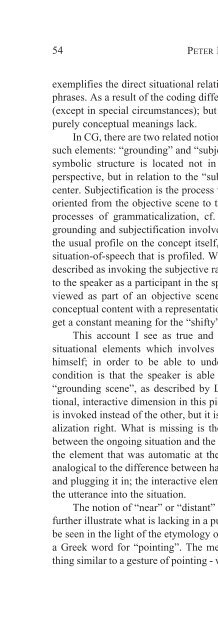Cognitive Semantics : Meaning and Cognition
Cognitive Semantics : Meaning and Cognition
Cognitive Semantics : Meaning and Cognition
Create successful ePaper yourself
Turn your PDF publications into a flip-book with our unique Google optimized e-Paper software.
POLYSEMY AND DIFFERENTIATION IN THE LEXICON 117<br />
flaskan gå runt samma väg som TV- go around the same way as the thermos.<br />
kannan. Redan innan dom fått ser Even before they’ve been served, Kurt <strong>and</strong><br />
Kurt och Göran glada och nöjda Göran look content. –Take a good slug<br />
ut.—Ta ordentligt nu, säger Lindgren now, Lindgren says when Mats pours. As<br />
när Mats slår i. Som för att ge sin if he wanted to give his blessing.<br />
välsignelse.<br />
In spite of this example showing the importance of the wider context, the<br />
major conclusion from the study of slå is that the local linguistic context<br />
makes it possible to determine the interpretation in the majority of cases. With<br />
some other verbs, the situation seems to be different. To what extent it is<br />
possible to use linguistic clues for the interpretation is an empirical question<br />
that must be determined from case to case.<br />
7. Sound source<br />
In Swedish, there are a large number of Sound-source verbs (Viberg 1978)<br />
such as susa ‘sigh’, ’sough’, surra ‘buzz’, mullra ‘rumble’. These verbs have<br />
a characteristic syntactic frame: det ___ prep NP y , where the NP refers to the<br />
source of the sound: Det susar i träden ‘The wind is sighing (lit. it is sighing)<br />
in the trees’, Det surrar i kupan There is a buzzing in the hive.). This frame is<br />
characteristic not only of sounds but of sense impressions in general. Semantically,<br />
the sound-source verbs are distinguished by the shared component:<br />
(FROM(TRAVEL))(SOUND, y).<br />
There is one group of verbs that could best be characterized as a combination<br />
of a physical contact verb <strong>and</strong> a sound-source verb (see Table 2 for a list).<br />
They are all frequentative, describing a series of repeated events acoustically<br />
<strong>and</strong> physically. One of these verbs dunka ‘bang, thump’ will be examined a<br />
little more closely. It can appear in the following syntactic frame which is<br />
highly characteristic of slå: Per dunkade Pål i ryggen ‘Per slapped Pål on the<br />
back (to cheer him up)’. As with slå, a certain emotional attitude is strongly<br />
implicated when the verb appears in this frame. The most characteristic parts<br />
of the lexical representation are shown in Table 10.<br />
In spite of the fact that dunka does not occur with very high frequency, it<br />
has a number of extended senses, which are displayed in Table 11. The<br />
idealized examples are based on actual examples from novels. The identification<br />
of the prototypical meaning is problematic. On the one h<strong>and</strong>, the most<br />
straightforward derivation of extended senses is obtained if the use as a















